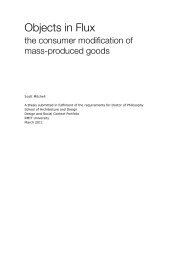Making Memory Space: Recollection and Reconciliation in Post ...
Making Memory Space: Recollection and Reconciliation in Post ...
Making Memory Space: Recollection and Reconciliation in Post ...
Create successful ePaper yourself
Turn your PDF publications into a flip-book with our unique Google optimized e-Paper software.
with historical mean<strong>in</strong>g are addressed, is relevant <strong>in</strong> underst<strong>and</strong><strong>in</strong>g the role that <strong>in</strong>dividual build<strong>in</strong>gs<br />
can play <strong>in</strong> the production of revised narratives, or the revision of entrenched narratives. It also<br />
suggests ways <strong>in</strong> which attitudes to architecture <strong>and</strong> those derived from it can contribute to the<br />
production of national narratives. The task of address<strong>in</strong>g these spaces operates as both a symbolic<br />
act <strong>and</strong> a touchstone for collective memory. Robert Bevan suggests that the act of physical<br />
transformation, choos<strong>in</strong>g which sites to reta<strong>in</strong>, which to demolish <strong>and</strong> which to reconstruct, can also be<br />
understood as form of selective recollection. 68 The tale of the past, as it is understood accord<strong>in</strong>g to the<br />
physical city, can be elided, filled <strong>in</strong>, blocked off or erased accord<strong>in</strong>g to differ<strong>in</strong>g attitudes to history<br />
<strong>and</strong> shift<strong>in</strong>g values over what is worth remember<strong>in</strong>g. This reality questions the notion that architecture<br />
exists as permanent marker, for built form is often only endur<strong>in</strong>g as long as it conforms to the<br />
prevail<strong>in</strong>g viewpo<strong>in</strong>t. In fact, manipulation of the so-called ‘permanence’ of the city contributes to the<br />
construction <strong>and</strong> revision of authoritative narratives, for the act of eradication of physical space<br />
colludes with the notion of wilful forgett<strong>in</strong>g.<br />
In effect memory space can be considered <strong>in</strong> two primary forms, the nationally sanctioned<br />
architectures of museums <strong>and</strong> memorials <strong>and</strong> the remnant sites which <strong>in</strong> themselves act as memorials<br />
through their role as witness to an event of the past. Michael Wise describes a schism between these<br />
two states of be<strong>in</strong>g - between the ‘concrete confrontation’ of sites where events took place <strong>and</strong> new<br />
memorials, which are created icons of the past. He posits an authentic/<strong>in</strong>authentic dialectic between<br />
these representatives of the past, out of which revised images of national identity emerge. 69 The<br />
question of authenticity <strong>in</strong> memory practice is a contentious one. In terms of museology, concepts of<br />
authenticity are bound up <strong>in</strong> notions of the ‘orig<strong>in</strong>al’, which is discussed later <strong>in</strong> this writ<strong>in</strong>g. In terms of<br />
architectural form, ideas of authenticity play a pivotal role <strong>in</strong> the establishment of local <strong>and</strong> national<br />
identity. <strong>Memory</strong> space often slides <strong>in</strong>to the <strong>in</strong>authentic realm <strong>in</strong> the contexts of enterta<strong>in</strong>ment <strong>and</strong><br />
tourism, spheres that regularly encroach on the historical world. The extent to which <strong>in</strong>authentic<br />
memory space may still effectively facilitate historical mean<strong>in</strong>g is discussed <strong>in</strong> Chapter Three. Similarly<br />
the authentic/<strong>in</strong>authentic dialectic is central to the success <strong>and</strong> failure of emergent memory space, <strong>in</strong><br />
terms of the creation of a localised, relevant aesthetic <strong>and</strong> is discussed <strong>in</strong> depth <strong>in</strong> Chapters Four <strong>and</strong><br />
Five.<br />
The context of built form <strong>in</strong> South Africa<br />
In order to critically analyse the spatial production <strong>in</strong> contemporary South Africa, it is useful to<br />
underst<strong>and</strong> the contextual architectural form already <strong>in</strong> existence there. This explanation of some of<br />
the significant spatial developments <strong>in</strong> South Africa highlights the extent to which built form can be<br />
68 Robert Bevan, Op cit, p.185.<br />
69 Michael Z. Wise, Capital Dilemma: Germany’s Search for a New Architecture of Democracy (New York: Pr<strong>in</strong>ceton<br />
Architectural Press, 1998), p.148.<br />
28
















